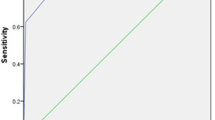Summary
Background
We aimed to research the relation of transaminase levels in blunt liver trauma (BLT) with the intensity of the trauma and the use of transaminase levels for deciding on surgical or non-operative treatment.
Methods
In all, 44 patients with BLT diagnosed by computerized tomography (CT) were involved in this retrospective study. By testing the correlation of the transaminase levels and the grade of liver injury with receiver operator characteristics (ROC), area under the curve (AUC) was calculated; besides, the sensitivity, specificity, and cut-off values of transaminases were calculated separately for the grades. Moreover, same method was repeated for the surgically and non-operatively treated patients. Cut-off value was assessed for surgical and non-operative treatments. The efficiency of transaminases in deciding non-operative treatment was compared with that of other methods using ROC test applied on focused abdominal sonography in trauma (FAST), hemodynamic instability, blood replacement rate, aspartate aminotransferase (AST), and alanine aminotransferase (ALT).
Results
It was observed that the AUC, sensitivity, and specificity increased correspondingly with the grade rise of transaminase levels in BLT. In the selection of non-operative treatment/surgery, following values have been confirmed: AUC for AST: 0.851 (sensitivity: 86 %, specificity: 73 %, cut-off value: 498 U/L), AUC for ALT: 0.880 (sensitivity: 86 %, specificity: 81 %, cut-off value: 498 U/L), AUC for replacement: 0.948 (sensitivity: 86 %, specificity: 94 %), AUC for hemodynamic instability: 0.902 (sensitivity: 86 %, specificity: 94 %), and AUC for FAST: 0.642 (sensitivity: 57 %, specificity: 75 %).
Conclusions
It was found that in BLT, transaminases can predict the injury rating with higher accuracy as the grade rises, and they outrival FAST in terms of determining the need for laparotomy.



Similar content being viewed by others
References
Christmas AB, Wilson AK, Manning B, Franklin GA, Miller FB, Richardson JD, et al. Selective management of blunt hepatic injuries including nonoperative management is a safe and effective strategy. Surgery. 2005;138:606–11.
Ritchie AH, Williscroft DM. Elevated liver enzymes as a predictor of liver injury in stable blunt abdominal trauma patients: case report and systematic review of the literature. Can J Rural Med. 2006;11:283–7.
Sola JE, Cheung MC, Yang R, et al. Pediatric FAST and elevated liver transaminases: an effective screening tool in blunt abdominal trauma. J Surg Res. 2009;157:103–7.
Tian Z, Liu H, Su X, Fang Z, Dong Z, Yu C, Luo K. Role of elevated liver transaminase levels in the diagnosis of liver injury after blunt abdominal trauma. Exp Ther Med. 2012;4:255–60.
Anadol AZ, Topgul K, Gungor B, Bilgin M, Kesim M. Non-operative management of blunt hepatic trauma. Ulusal Travma Dergisi. 2007;13:222–6.
Ozogul B, Kısaoglu A, Aydınli B, Ozturk G, Bayramoglu A, Sarıtemur M, et al. Non-operative management (NOM) of blunt hepatic trauma: 80 cases. Ulus Travma Acil Cerrahi Derg. 2014;20:97–100.
van der Wilden GM, Velmahos GC, Emhoff T, Brancato S, Adams C, Georgakis G, et al. Successful nonoperative management of the most severe blunt liver injuries: a multicenter study of the research consortium of new England centers for trauma. Arch Surg. 2012;147:423–8.
Sahdev P, Garramone R, Schwartz R, et al. Evaluation of liver function tests in screening for intra-abdominal injuries. Ann Emerg Med. 1991;20:838–41.
Stassen N, Lukan J, Carrillo E, et al. Examination of the role of abdominal computed tomography in the evaluation of victims of trauma with increased aspartate aminotransferase in the era of focused abdominal sonography for trauma. Surgery. 2002;132:642–6.
Miller K, Kou D, Sivit C, et al. Pediatric hepatic trauma: does clinical course support intensive care unit stay? J Pediatr Surg. 1998;33:1459–62.
Risholm L, Sullivan L. Changes in the transaminase and phosphatase activity of the blood and the occurrence of haemobilia following experimental liver trauma in the rabbit. Acta Chir Scand. 1966;131:495–8.
Karam O, La Scala G, Le Coultre C, Chardot C. Liver function tests in children with blunt abdominal traumas. Eur J Pediatr Surg. 2007;17(5):313–6.
Sola JE, Cheung MC, Yang R, Koslow S, Lanuti E, Seaver C, Neville HL, Schulman CI. Pediatric FAST and elevated liver transaminases: an effective screening tool in blunt abdominal trauma. J Surg Res. 2009;157:103–7.
Tan KK, Bang SL, Vijayan A, Chiu MT. Hepatic enzymes have a role in the diagnosis of hepatic injury after blunt abdominal trauma. Injury. 2009;40:978–83.
Matthes G, Stengel D, Seifert J, et al. Blunt liver injuries in polytrauma: results from a cohort study with the regular use of whole-body helical computed tomography. World J Surg. 2003;27:1124–30.
Zago TM, Pereira BM, Calderan TR, Hirano ES, Rizoli S, Fraga GP. Blunt hepatic trauma: comparison between surgical and nonoperative treatment. Rev Col Bras Cir. 2012;39:307–13.
Bonariol L, Massani M, Caratozzolo E, Ruffolo C, Recordare A, Scarpa M, Stecca T, Cegolon L, Bassi N. Management of grade III-IV blunt liver traumas: a comparative, observational study. Minerva Chir. 2014. Epub ahead of print.
Swift C, Garner JP. Non-operative management of liver trauma. J R Army Med Corps. 2012;158:85–95.
Tamura N, Ishihara S, Kuriyama A, Watanabe S, Suzuki K. Long-term follow-up after non-operative management of biloma due to blunt liver injury. World J Surg. 2014;39:179–83.
Lingawi SS, Buckley AR. Focused abdominal US in patients with trauma. Radiology. 2000;217:426–29.
Cohn SM, Arango JI, Myers JG. Computed tomography grading systems poorly predict the need for intervention after spleen and liver injuries. Am Surg. 2009;75:133–39.
Deunk J, Brink M, Dekker HM, Kool DR, Blickman JG, van Vugt AB, Edwards MJ. Predictors for the selection of patients for abdominal CT after blunt trauma: a proposal for a diagnostic algorithm. Ann Surg. 2010;251:512–20.
van der Vlies CH, Olthof DC, Gaakeer M, Ponsen KJ, van Delden OM, Goslings JC. Changing patterns in diagnostic strategies and the treatment of blunt injury to solid abdominal organs. Int J Emerg Med. 2011;27:44–7.
Author information
Authors and Affiliations
Corresponding author
Rights and permissions
About this article
Cite this article
Koca, B., Karabulut, K., Ozbalci, G. et al. Is it possible to use transaminases for deciding on surgical or non-operative treatment for blunt liver trauma?. Wien Klin Wochenschr 127, 954–958 (2015). https://doi.org/10.1007/s00508-015-0708-8
Received:
Accepted:
Published:
Issue Date:
DOI: https://doi.org/10.1007/s00508-015-0708-8




